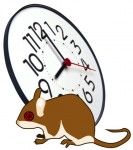 Almost all plants and animals have an internal “clock” – called a circadian clock – that synchronizes our biological rhythms with Earth’s cycle of day and night. Conveniently, our biological clocks are best at synchronizing to a 24 hour day, the length of time it takes for the Earth to rotate. This clock cues us mammals to get sleepy at around the same time every nightor day if you're nocturnal, but it also regulates a plethora of other internal cycles that we might be less aware of. In fact, scientists still don’t know just how much the circadian clock controls.
Almost all plants and animals have an internal “clock” – called a circadian clock – that synchronizes our biological rhythms with Earth’s cycle of day and night. Conveniently, our biological clocks are best at synchronizing to a 24 hour day, the length of time it takes for the Earth to rotate. This clock cues us mammals to get sleepy at around the same time every nightor day if you're nocturnal, but it also regulates a plethora of other internal cycles that we might be less aware of. In fact, scientists still don’t know just how much the circadian clock controls.
But a new study in PNASProceedings of the National Academy of Sciences examines what happens when you throw off mice’s circadian clocks for an extended period of time. We’re not talking about simple jet lag here – like humans, a mouse’s biological clock can adjust after a few days in a new time zone. Instead, this study replaced the normal 24 hour day with a much shorter artificial 20 hour day, consisting of 10 hours of light followed by 10 hours of darkness. This cycle was kept up for 10 weeks.
 Three major differences became apparent between the control mice (12 h light/12 h dark) and the 20-hour-day mice. The circadian-disrupted mice gained weight, had trouble learning some new things, and had altered “emotions”. These changes were consistent with other physiological differences that the researchers found when they examined the mice more closely.
Three major differences became apparent between the control mice (12 h light/12 h dark) and the 20-hour-day mice. The circadian-disrupted mice gained weight, had trouble learning some new things, and had altered “emotions”. These changes were consistent with other physiological differences that the researchers found when they examined the mice more closely.
Weight Gain. The researchers started noticing that the 20-hour-day mice were getting chubby compared to the control mice after about 4-5 weeks of their unnatural light schedule. From then on, the mice’s weight problem kept getting worse all the way through the end of the 10 weeks. During the entire 7th week, the researchers monitored the mice’s food intake (they were all allowed to eat as much as they wanted), but the 20-hour-day mice weren’t actually eating any more food than the normal mice. Instead, it seemed that their metabolism was just slowing down. Blood tests at the end of the 10 weeks showed that the 20-hour-day mice had higher levels of certain hormones related to metabolism – insulin and leptin.
 Decreased Cognitive Flexibility. The researchers tested the mice’s ability to learn new things by putting them in a water maze that required them to make their way to an escape platform that was in one corner. The 20-hour-day mice were able to “solve” the maze just as quickly as the 24-hour-day mice. But once the mice were all used to the maze and the platform, those sneaky scientists moved the platform over to a different corner. The maze setting was the same, but the end goal was in a different spot. It took the 20-hour-day mice a lot longer to figure this out than it took the 24-hour-day mice.
Decreased Cognitive Flexibility. The researchers tested the mice’s ability to learn new things by putting them in a water maze that required them to make their way to an escape platform that was in one corner. The 20-hour-day mice were able to “solve” the maze just as quickly as the 24-hour-day mice. But once the mice were all used to the maze and the platform, those sneaky scientists moved the platform over to a different corner. The maze setting was the same, but the end goal was in a different spot. It took the 20-hour-day mice a lot longer to figure this out than it took the 24-hour-day mice.
This diminished ability of the mice to alter their learning was consistent with some observable negative changes (dendrite shrinkage, decreased neuron complexity) to the mice’s prelimbic prefrontal cortex. This is a region of the brain that is known to be important for cognitive flexibility (learning and adapting) and also for emotional control.
Mouse “Emotions”. You might need a mouse shrink to figure out if a mouse is happy or sad, but these researchers instead looked at how a mouse’s inhibition was affected by circadian clock disruption. Essentially, the mice were put into an environment that contained something unfamiliar – either a wide open space or a brightly lit area (when the mice were coming from the dark). The 20-hour-day mice entered the unfamiliar areas more quickly than the control mice, who were shyer about running into the open or the bright light. This decreased inhibition is, again, consistent with the observed physiological changes to the prelimbic frontal cortex.
It is unknown how this study relates to humans, but many professions require workers to undergo frequent and chronic circadian disruption (doctors, pilots, military personnel, etc.). This type of mouse experiment could provide a method for testing pharmaceutical drugs or other remedies for people that have to work on weird schedules.
Though this study is certainly interesting, I would like to know how much sleep the mice got. Other research has already linked sleep deprivation to mental and physical health problems, so it’s a little unclear if this study shows an inherent need for a 24-hour day, or if it just illustrates a new way of making mice sleep-deprived.
Citation:
Karatsoreos IN, Bhagat S, Bloss EB, Morrison JH, & McEwen BS (2011). Disruption of circadian clocks has ramifications for metabolism, brain, and behavior. Proceedings of the National Academy of Sciences of the United States of America PMID: 21220317


Great post. Thanks for putting it up.
Yes, even the earth will have more mass if its rotation speed gets higher. That is because the forward moving speed will be delimited. See http://www.die-absolute-theorie.de (on German) for more details on my physcs science. Or the even smaller wiki absolute-theory.com. Rotation, mass and energy are equivalent in physics.
has there been any work on changing circadian cycles the other way, as in xkcd 320?
http://xkcd.com/320/
Wikipedia mentions this proposed 28-hour day, but it also says that humans can’t actually adjust to this length of day – forcing conditions are required. However the Wikipedia article is not much more informative than the xkcd, and less funny.
The earth’s rotation slows down (conservation of angular momentum – tides casused by the moon, earth’s rotation slows, moon gets further) rather than speeds up. I’d enjoy seeing the results of a longer rather than shorter day/night.
I’d also wonder what the effects would be if the changes in day/night were introduced incrementally over several generations of mice.
Excellent idea. Of course, the authors don’t mention anything about an interest in what would happen if the earth’s rotation changes… there are much more immediate/relevant/fundable reasons to be curious about disruptions to circadian rhythm. The earth’s rotation speed is really just a silly extension on my part.
The incremental changes to mice’s internal clock over several generations could be pretty cool. The authors of this paper mention a mutant mouse (CLOCK) that has a genetically messed up circadian clock and apparently also has a slowed metabolism – results of studies with the CLOCK mouse are published here in Science.
This entire premise was described, with 100’s of scientific citations, eleven years ago in a book, “Lights Out: Sleep, Sugar and Survival” It was the first published piece that stitched together the spin of the earth, human metabolism and molecular biology. I find it sad that “scientific” studies (with enormous funding) are just now learning what T.S. Wiley figured out almost a dozen years ago. Her appearance on shows like Today and Good Morning America were met with disbelief and almost derision.
A hundred years ago, there were no scientists, just people who loved science. Today, it’s like a country club.
-Neil Raden
can someone explain to me how Michel Siffre’s experiments gel with this? like how do we know that the fact that there’s night and day doesn’t create the 24 hour circadian cycle for us, vs. people intrinsically having a 24 hour cycle and the earth’s rotation just happens to sync up?
(i know, it’s basically the xkcd question over again, but i first heard of Siffre in AP Psych like 6 years ago and i haven’t heard anyone refute his findings in the intervening time. …not that i spend a lot of time reading blogs about circadian rhythms though…)